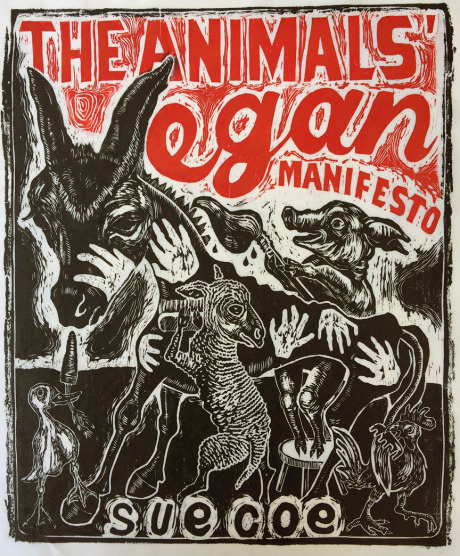New School student, Tracy Fernandez, interviews artist Sue Coe in anticipation of her lecture on Tuesday Oct. 3rd, part of the NY Comic and Picture Story Symposium , and in anticipation of her exhibition, “All Good Art is Political” with Käthe Kollwitz at the Galerie St. Etienne, part of New York Print Week (October 23rd – October 29th).
Sue Coe’s NYCPSS lecture will be for her new, all-picture book, “The Animals’ Vegan Manifesto.”

FERNANDEZ: What medium do you prefer to work in? Why?
COE: I prefer pencil then woodcut then litho. I prefer to draw as if it were painting and cut wood like a drawing. It’s elegant and simple.

The Veal Skinner, 1991. Stone lithograph.
FERNANDEZ: What do animals mean to you? How did your experience living near a slaughterhouse shape that meaning?
COE: The injustice of the way animals are bred to be slaughtered is intolerable. The pain animals feel is more than they can bear. The meat industry has exponentially become increasingly psychotic, murdering trillions of animals every year and devastating wildlife, human health, and the planet. Animal liberation is a social justice movement, like any other, it demands an end of all animal use. Slaughterhouses are concealed from most people, but in my childhood, the slaughterhouse was my house.
FERNANDEZ: In order to create graphic, violent imagery of animal cruelty, did you rely on visiting slaughterhouses or mostly work from memory?
COE: The imagery is the reflection of reality drawn to create change. Many of the scenes I have witnessed directly. Some I have not drawn at all, yet. As Beckmann said about being in the trenches of WW1 – my art eats here.
FERNANDEZ: As an illustrator who works in multiple mediums, what techniques do you use specifically to communicate these graphic scenes to an audience?
COE: When I started out as an illustrator there was little color in mass media publications, so I was trained to stay within black and white, and used tone to suggest color. I rarely work for commercial publications any more, as create my own words and images. I lean toward sequential reportage work. I invented my own art world, within the art world, but stay within the concept that technique is the test of sincerity. My gallery and my frequent book publisher are extremely supportive.

Sue Coe, Red Slaughterhouse, 1988. Excerpted from Cruel, page 71.

Butcher to the World, 1986. Excerpted from Cruel, page 20.
FERNANDEZ: Would you consider your artworks to be a form of activism? If so, what does it mean to you to be an activist/protester?
COE: I do consider art and activism to be one and the same. If people are not protesting by now, they are not paying attention. The crime is indifference. I can raise money for different non profits selling cheap prints, people get ‘art’ and the pleasure of knowing they are helping. Anyone can do this.
FERNANDEZ: With your artwork regarding animal cruelty and human injustice, what impact do you intend to have on an audience?
COE: I believe in truth based activism. Deteriorating social conditions create the resistance, as well as embolden the extreme right. We are the audience (now defined as product) witnessing the crime of corporate greed and destruction of life. How that impacts me personally, is making the art which slows time down long enough to resist.
FERNANDEZ: In the height of political chaos, what role do you feel that art and design hold in relation to politics?
COE: Art and design, if it is linked to mass struggle can be highly effective. You can’t have a political art uncoupled from political struggle. The ruling class are attempting to silence dissent, by blaming the victims. It’s the oldest trick in the book, along with divide and conquer. Art is a positive non-violent way people can speak to each other across walls and borders.

Wall Street Walk by Sue Coe, 2012.
2 Color Lithograph
36”x26”
Sue Coe’s work, Wall Street Walk, which she made in the Print Shop at Parsons and is now part of The New School Art Collection, details in the video below where the terms “wall street” and “stock market” originate from.
